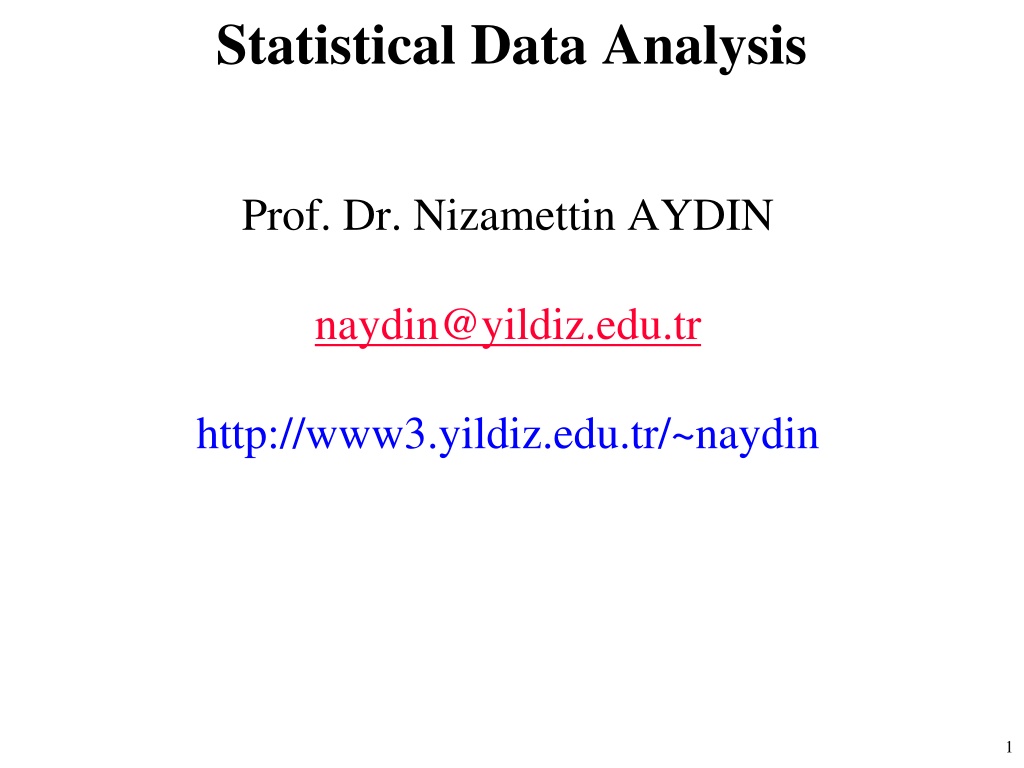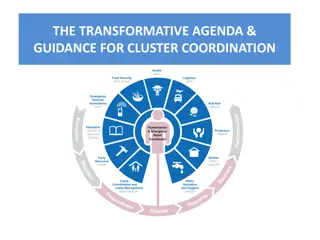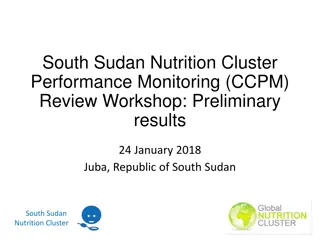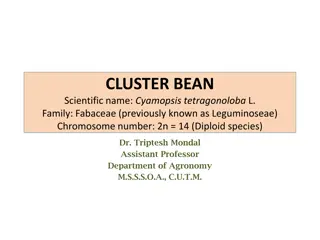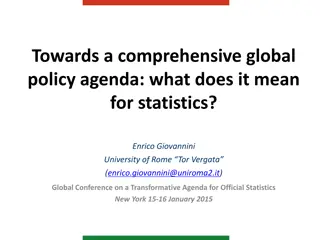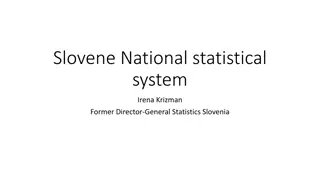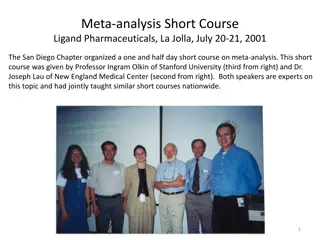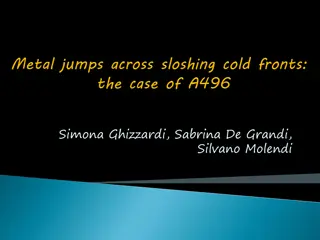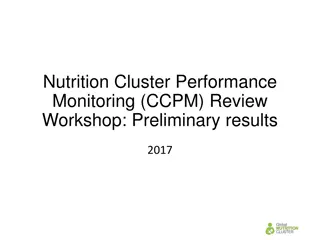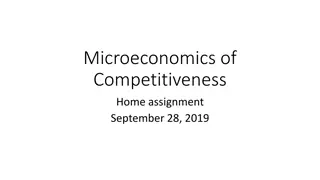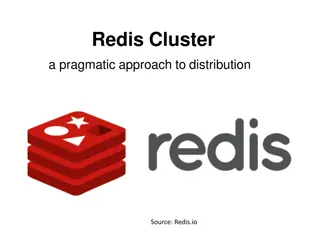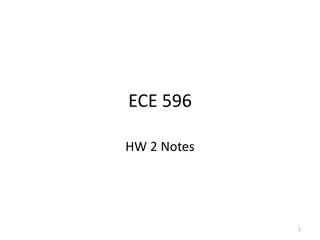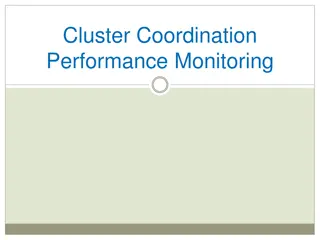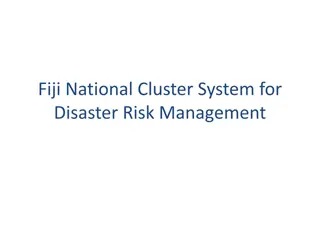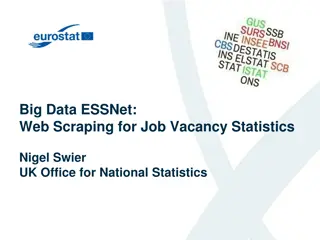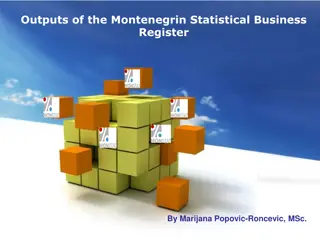Understanding Cluster Analysis in Statistical Data Analysis
Cluster analysis is a vital method in statistical data analysis that aims to identify subgroups within a population based on similarities between observations. It involves techniques like building regression models for supervised learning and utilizing distance measures for assessing dissimilarity. Through concepts like similarity, dissimilarity, and various distance metrics like Euclidean and Minkowski distances, cluster analysis helps in uncovering hidden structures in data sets.
- Cluster Analysis
- Statistical Data Analysis
- Supervised Learning
- Unsupervised Learning
- Distance Measures
Download Presentation

Please find below an Image/Link to download the presentation.
The content on the website is provided AS IS for your information and personal use only. It may not be sold, licensed, or shared on other websites without obtaining consent from the author. Download presentation by click this link. If you encounter any issues during the download, it is possible that the publisher has removed the file from their server.
E N D
Presentation Transcript
Statistical Data Analysis Prof. Dr. Nizamettin AYDIN naydin@yildiz.edu.tr http://www3.yildiz.edu.tr/~naydin 1
Introducion Linear regression models are used to predict the unknown values of the response variable. In these models, the response variable has a central role; the model building process is guided by explaining the variation of the response variable or predicting its values. Therefore, building regression models is known as supervised learning. Supervised learning: the machine learning task of learning a function that maps an input to an output based on example input- output pairs. infers a function from labeled training data consisting of a set of training examples 3
Introducion Building statistical models to identify the underlying structure of data is known as unsupervised learning. An important class of unsupervised learning is clustering, which is commonly used to identify subgroups within a population. Cluster analysis refers to the methods that attempt to divide the data into subgroups such that the observations within the same group are more similar compared to the observations in different groups. 4
Distance Measure The core concept in any cluster analysis is the notion of similarity and dissimilarity. It is common to quantify the degree of dissimilarity based on a distancemeasure, which is usually defined for a pair of observations. The most commonly used distance measure is the squared distance, dij= (xi xj)2 dijrefers to the distance between observations i and j xiis the value of random variable X for observation i xjis the value for observation j 5
Similarity and Dissimilarity Similarity is a numerical measure of how alike two data objects are is higher when objects are more alike often falls in the range [0,1] Dissimilarity is a numerical measure of how two data objects are different is lower when objects are more alike Minimum dissimilarity is often 0 Upper limit varies Proximity refers to a similarity or dissimilarity 6
Distance Euclidean Distance n is the number of dimensions (attributes) pk and qk are, respectively, the kth attributes (components) or data objects p and q. Minkowski Distance a generalization of Euclidean Distance ? (?? ??)2 ?=1 ???? = 1 ? ? |?? ??|? ???? = ?=1 r is a parameter n is the number of dimensions (attributes) pk and qk are, respectively, the kth attributes (components) or data objects p and q. 7
Distance In Minkowski Distance, if r = 1 dist is City block (Manhattan, taxicab, L1 norm) distance. if r = 2 dist is Euclidean distance if r = dist is supremum (Lmax norm, L norm) distance. In general, if we measure p random variables X1, . . . , Xp, the squared distance between two observations i and j in our sample is dij= (xi1 xj1)2+ +(xip xjp)2. This measure of dissimilarity is called the squared Euclidean distance. 8
Example Suppose that we believe that while European countries are different with respect to their protein consumption, they could be divided into several groups such that countries within the same group can be considered similar to each other in terms protein consumption. Here, we use the Protein data set we discussed earlier. It includes numerical measurements of the protein consumption from 9 different sources: RedMeat, WhiteMeat, eggs, Milk, Fish, Cereals, Starch (starchy foods), nuts (pulses, nuts, and oil-seeds), and Fr.Veg (fruits and vegetables). To start, suppose that we want to group countries according to their consumption of red meat (redMeat) and fish (Fish). More information about the data can be found at http://lib.stat.cmu.edu/DASL/Datafiles/Protein.html 9
Example In the Protein data set, the first two countries are Albania and Austria. Suppose we want to measure their degree of dissimilarity (i.e., their distance) in terms of their consumption of red meat and fish given in the following table. 10
Example The squared distance between these two countries (10.1 8.9)2= 1.44 in terms of red meat consumption (0.2 2.1)2= 3.61 in terms of fish consumption. To find the overall distance between these two countries, we add the distances based on different variables: d = 1.44+ 3.61 = 5.05 11
K-means Clustering K-means clustering is a simple algorithm that uses the squared Euclidean distance as its measure of dissimilarity. After randomly partitioning the observations into K groups and finding the centeror centroidof each cluster, the K-means algorithm finds the best clusters by iteratively repeating the following steps For each observation, find its squared Euclidean distance to all K centers, and assign it to the cluster with the smallest distance. After regrouping all the observations into K clusters, recalculate the K centers. These steps are applied until the clusters do not change i.e., the centers remain the same after each iteration. 12
K-means Clustering An example of visualizing the results of K-means clustering with a scatterplot (with R-Commander). The three clusters are represented by circles, triangles, and crosses. They clearly partition the countries into a group with a low consumption of fish and red meat, a group with a high consumption of fish, a group with a high consumption of red meat. 13
Hierarchical Clustering There are two potential problems with the K-means clustering algorithm. It is a flat clustering method. We need to specify the number of clusters K a priori. An alternative approach that avoids these issues is hierarchical clustering. The result of this method is a dendrogram (a tree). The root of the dendrogram is its highest level and contains all n observations. The leaves of the tree are its lowest level and are each a unique observation. 14
Hierarchical Clustering There are two general algorithms for hierarchical clustering: Divisive (top-down): We start at the top of the tree, where all observations are grouped in a single cluster. Then we divide the cluster into two new clusters that are most dissimilar. Now we have two clusters. We continue splitting existing clusters until every observation is its own cluster. 15
Hierarchical Clustering Agglomerative (bottom-up): We start at the bottom of the tree, where every observation is a cluster i.e., there are n clusters. Then we merge two of the clusters with the smallest degree of dissimilarity i.e., the two most similar clusters. Now we have n 1 clusters. We continue merging clusters until we have only one cluster (the root) that includes all observations. 16
Hierarchical Clustering We can use one of the following methods to calculate the overall distance between two clusters Single linkage clustering uses the minimum dijamong all possible pairs as the distance between the two clusters. Complete linkage clustering uses the maximum dijas the distance between the two clusters. Average linkage clustering uses the average dijover all possible pairs as the distance between the two clusters. Centroid linkage clustering finds the centroids of the two clusters and uses the distance between the centroids as the distance between the two clusters. 17
Hierarchical Clustering The following figure illustrates the difference between the single linkage method, the complete linkage method, and the centroid linkage method to determine the distance dijbetween the two clusters shown as circles and squares. Note that the dotted line connects the centers (as opposed to observations) of the two clusters. There are of course other ways for defining the distance between two clusters. However, the above measures are the most commonly used. 18
Hierarchical Clustering As an example, follow the following procedures in R- Commander to perform complete linkage clustering to create a dendrogram of countries based on their protein consumption. Click Statistics Dimensional analysis Cluster analysis Hierarchical cluster analysis. Select all nine food groups (hold the control key) for the Variables. Next, choose Complete Linkage as the Clustering Method and Squared-Euclidean as the Distance Measure. Lastly, make sure the option Plot Dendrogram is checked. R-Commander then creates a dendrogram similar to the one shown in the next slide 19
Hierarchical Clustering The dendrogram resulting from complete linkage clustering of the 25 countries based on their protein consumption. The dashed line shows where to cut the dendrogram to create three clusters 20
Hierarchical Clustering The clusters seemed to be defined by geographic location: Balkan countries (Romania, Bulgaria, and Yugoslavia), Scandinavian countries (Finland, Norway, Denmark, and Sweden), Western European countries (UK, Belgium, France, Austria, Ireland, Switzerland, Netherlands, and West Germany), Eastern European countries (East Germany, Hungary, Czechoslovakia, Poland, Albania, USSR) the Mediterranean countries (Portugal, Spain, Greece, Italy). 21
Hierarchical Clustering As an example, consider four species characterized by homologous sequences ATCC, ATGC, TTCG, and TCGG. Taking the number of differences as the measure of dissimilarity (Hamming distance) between each pair of species, use a simple clustering procedure to derive phylogenetic tree. 22
Hierarchical Clustering First: form the distance matrix: ATCC ATGC TTCG TCGG ATCC ATGC TTCG TCGG 23
Hierarchical Clustering The distance matrix: ATCC ATGC TTCG TCGG 1 0 ATCC ATGC 0 1 2 3 4 3 TTCG 2 3 0 2 TCGG 4 3 2 0 Smallest nonzero distance is 1 Therefore first cluster is {ATCC, ATGC} The tree will contain the following fragment: ATCC ATGC 24
Hierarchical Clustering Reduced distance matrix is: {ATCC,ATGC} 0 2.5 3.5 TTCG (2+3)/2 0 2 TCGG (4+3)/2 2 0 {ATCC,ATGC} TTCG TCGG Next cluster is: {TTCG, TCGG} Linking the clusters gives the following tree: 1.5 1.5 0.5 0.5 1 1 ATCC ATGC TTCG TCGG 25
